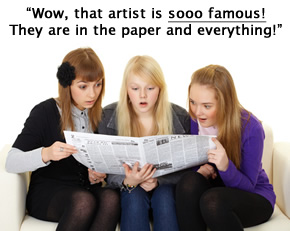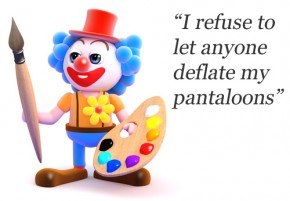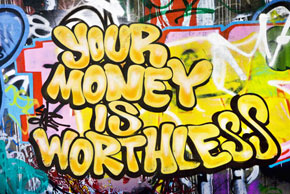This is a checklist things you need to think about when putting on your own art show. If you take the time to prepare up front your show will come across as slick, well organised and professional, which in turn gives potential buyers of your art confidence.
Getting your artwork ready for the show
Photograph your art work. Once it gets purchased then you might never see it again!
Frame your artwork if required. Allow plenty of time for your picture framer to do a quality job.
Make sure all your artworks are suitable for hanging or display with strings and D-rings attached.
Wrap your artworks up ready for transportation. Buy bubble wrap in bulk lots from a packaging wholesaler or supplier. Don’t buy small rolls from your office supplier. or you will pay too much.
Blankets are a cheap alternative but not as neat.
Arrange a truck, hatchback or station wagon to transport your works.
Certificates of Authenticity. Make one for each artwork. Have a special rubber stamp made up to use with the certificate. It looks great and buyers love them.
Sponsorship
- Consider bringing in other businesses to sponsor your exhibition.
- Feature them prominently on your exhibition catalogue.
- Ask businesses to sponsor lucky door prizes.
- Make sure you mention the sponsors clearly for each prize draw they sponsor.
- You may even be able to get sponsorship for catering.
- Arrange goodie bags for each exhibition attendee containing sponsor leaflets, any freebies and your business card.
Recording the event
- Arrange a photographer
- Arrange a video camera operator
- Contact press photographers and ask them to come along
Hanging your exhibition
- Measure the exhibition space and plan how you will hang you artworks.
- Does the space need themeing or decorating in some way to give it extra pizazz?
- Make sure you have hanging equipment suitable for the space you will be displaying in. You may need to investigate the space closely to figure out how you will hang the works if it’s not a gallery with built in rails.
- In some spaces without obvious wall hanging opportunities you may have to hire in stands from an exhibition hire company.
- When you deliver your artworks to the venue, lean them against the wall directly underneath where you will be hanging them, so you can get a feel for the layout and your hanging assistants will get a better idea of what they are doing.
[et_bloom_inline optin_id=”optin_3″]
Formalities
- Create a ‘running order’ for the show, which details the timing of events on the opening night. Distribute it to everyone involved in the show.
- Invite a VIP person to open the show for you.
- Brief your VIP with things they might like to mention.
- Appoint an MC who will introduce both the VIP, yourself and any other speeches or exhibition events.
- Prepare a speech. People will want to hear from you the great artist!
- Announce any prize draws at least twice during the night.
- What are your show opening and closing times. Decide up front how log the show will go for.
The Entertainment
- What nibblies will you provide?
- What drinks will you provide? Remember to provide both alcoholic and soft drinks. I once had a slushie machine and added spirit to the mix. Instant self service cocktails!
- Hire in professional caterers if you haven’t got time to do it yourself.
- Hire professional wait staff or get some friends in to assist with serving.
- Do you need musicians, a DJ or at least someone to change a carefully chosen CD once in a while?
Sales
- Create lables for every artwork containing the title, price, medium and size.
- Try and have artworks priced in various ranges, so that everyone has an opportunity to buy something.
- Get some red stickers for artworks sold on the night.
- Try and have some artworks that are hanging but have been presold before the opening night with red dots on them. It gives people confidence and encourages them to buy.
- Appoint sales assistants and let them know how to process sales
- Set up a system for receipting. This could be as simple as a carbon copy receipt book.
- Keep details of all prices handy for your sales assistant.
- Have a till or cash tin and keep it secure
- Provide credit card processing facilities if you can. People are more likely to impulse buy if they can whack it in their credit card. If you are serious about this business then you should arrange a merchant account with a bank so you can process credit cards.
- Be prepared to provide shipping and packaging costs. Some people will not buy unless they know these things up front. Your freight company should be able to provide a table. Estimate packaging weight and size for each artwork before the exhibition so you can quote quickly.
- When someone seems interested in buying, don’t be afraid to ask for the sale. “Would you like to take this artwork home with you tonight?”
- If a person wants to negotiate, state your price with confidence and then shut up! Let the buyer make the next move and then lead the sale to a conclusion. “How would you like to pay for that?”
Things not to do
- Don’t underestimate the amount of time it will take to hang your exhibition.
- Don’t be a diva. If things aren’t going right, negotiate gently. Just because many legendary artists were quite temperamental doesn’t mean you have to be.
- In your speech, if you stuff up and miss some important things you wanted to say don’t let everyone know by fluffing around. Nobody knows what you are about to say other than you and any stuff ups you make will probably go unnoticed anyway.
- Don’t get drunk. It’s easy to do as you will be running on adrenalin and people will keep serving you drinks as you are the most important person there.
- Don’t ignore people or be shy. It’s your party. People want to know and meet you.
- Don’t get caught up talking to one person. You need to circulate. Pay special attention to potential buyers and VIP’s though.
- Don’t get depressed if people are not buying your artworks on the night. People sometimes have to think about an expensive purchase. Follow up any leads after the show.
- Don’t make artworks that can only be sold as a set. People are contrary and will often just want one.
- Don’t fluff around when people ask you the price of an artwork. Know your prices. State them clearly with conviction. Your confidence will tell the potential buyer that your artwork is worth what you are asking.
- Don’t forget to thank everyone who was personally involved in helping to put on your show.












Great article!
thanks very much , really very precious tips ,,, i am preparing for my first exhibition and was wandering, asking about a lot of those things
Lots of great tips! Wish I had read the article prior to tonight–I have a show this evening. Definitely keep these ideas in mind for next time.
Very Helpfull! I am taking responsibillity for a group exhibit of all our local artis and your article will help.
Thanks
WOW! Thanks for this! I will definantly keep this in mind as I plan out my show!
This article is very helpful. I will keep this in mind for my show in a few months.
Thanks.
This is fantastic! Have to get to work.
Thanks for the great list of tips. Things you know and forget at the last minute.
I am new to exhibitions. This checklist was extremely helpful. I am definitely going to reference it for my upcoming exhibition. Thanks a bunch!
My exhibition opens this coming Saturday 27th October. It’s in a commercial gallery in Double Bay and I’ve exhibited there several times in the past. The gallery provides a full bar of bubbly, white wine, red wine, orange juice and mineral water. Is it really necessary to provide food? If so what kind?
I was opting for the no food option to make it more professional perhaps…? My husband Tony discovered your site yesterday and has already written to you re photographing my paintings. Cheers Camille
Hi Camille,
Yes, the bubbly, red, white, orange drinks is what serious art buyers expect so thats spot on.
For food its best to go for finger food of the non messy variety. Little neat suchi can be good, crackers with nice colourful toppings, samosas, savoury pastries, meatballs on toothpicks and dipping sauce etc all help people stick around longer to chat and admire the artworks. Its just a little treat that makes people feel a bit special.
Ive experienced exhibitions both with and without food. People actually get a bit miffed I feel if there is no catering. Often they will miss having something to eat before an exhibition because they expect there will be some snacks. They soon get hungry and wander off when there is no food available.
So I’d say dont skimp on the nibblies, keep tummys happy and wine glasses full for maximum potential buyer stick-aroundness. Lavishness of catering should be factored in to refect your artwork pricing level and how many artworks you realisticly expect to sell.
Hmmm…
Im starting to feel hungry now.
Thank you, feeling a bit more confident for my first exhibition now 🙂
this is fantastic!!!!!
we are preparing for exhibition and i didn’t know where to start,surely this will help…thank you.
I STILL HAVE NO IDEA WHAT FOOD!!
Hi, I want to set up show in private house, is there any legal regulations that I need to follow? Thanks.
I’d suggest checking with your local council. Regulations will vary depending where you are. You should try and get on good terms with the neighbours too.
im organizing one at my school any help please
What kind of help do you need?
Nice article Stuart! Great ideas. I’ve not thought about asking sponsors to create door prizes. I’m a professional landscape painter in Memphis, TN. I have a relatively big exhibit this Sunday with 40 plein air paintings and 3 large studio paintings. You’re right, don’t underestimate the time needed to prepare. Framing 40 paintings took many hours to complete and weeks of planning- plus the time to ship them and put them together. I ordered frames from two wholesalers, and two local shops, so I had a lot of variety. Just making titles and labels with pricing took a full day. We hung the show in about seven hours- with two people.
Sometimes I lay out a show with a diagram if I know the size of the walls in advance. In a Word or other type document, I set up a page that’s actually the size of the wall, So instead of letter size, it’s 8 ft x 26 ft or whatever size page. Then I take pictures of all the artwork, crop them, and when I insert them I adjust the size of the images so they are to scale. Then you can move things around and plan spacing in advance. Another less computer driven way is to set up you camera a distance away from your art, such that you can take every picture the same distance from the art, so the images are all the same relative scale. Then print out all these without cropping them, say 4 or more per letter size sheet, cut the artwork image out, then you have all your paintings to scale, and can move them around like paper dolls.
Other things not to forget:
-Plan how you will advertise- make sure you send out notices to local paper weeks in advance to meet their deadlines. Post regularly on Social Media, giving people an idea of how things are going, with images of your preparation and artwork. I put up posters too around town, and made letter size and smaller flyers to give out to friends in person, and sometimes mail out postcards. I maintain a list of art followers on Mailchimp.com, and can send group emails that way with a “save the date” email, etc.
More about me and my art here: http://www.matthewleestudio.com
I work for a non profit that aids individuals with special needs and developmental disabilities. My job is to help them create their own artwork and give them some opportunities for creative expression.
I’ve been tasked with putting together an art show that will be open to artists with disabilities from all over the USA.
They didn’t teach us a dang thing about putting on this sort of event in art school.
I think that this article was amazing, and it really helped me to begin building my own checklist for what I’m going to need to do.
Thank you for taking the time to write this.
thanks for the article – My daughter is doing her 1st solo show in November. It is at a local Comic Book store, and we have been told that getting people there is up to us. We have already started with social media, putting the word out there, and will do more as it gets closer (don’t want to over do it now), we will also be doing flyers for local shops.
Do you have any advice on getting media coverage?
Do you know of sites that list art openings?
We’ve got a few articles with promotion ideas…(you may have read them already…but worth restating)
https://drawpj.com/how-to-artist-press-release/
https://drawpj.com/find-a-famous-friend-to-open-your-exhibition/
https://drawpj.com/is-your-art-a-charity-case/
but the very best way to do it we’ve found is direct person to person invitations, especially when starting out.
this is post is a bit old school, but its still good…
https://drawpj.com/how-to-promote-your-art-exhibition-with-a-mini-art-folio/
and
https://drawpj.com/begging-for-your-business-card/
These days I would also recommend collecting email addresses and adding people to a proper mailing list using aweber. mailchimp or similar.
Email still works better than social media I find.
Top tip…don’t invite all your family and friends…they will probably eat your food, drink your drink and not buy anything. It will be a nice party though. Actually invite people who are interested in buying art if your aim is to sell it…but to sum up..
Just starting out…invite actual real people personally…remind them how important you are with a bit of local media coverage just before the event…follow up with personal emails / texts / phone calls to ensure they turn up! 🙂
This has been the most helpful article I’ve read.
I have a question, how many pieces/artworks should there be at the least to be exhibited?
I usually go for at least 24 pieces, but it really depends on what kind of works you are creating, the size of the works ,and the size of the space you will be exhibiting in.
Doing my first exhibition this year and will really use this information given on the article, thanks
Do you recommend posting pictures of exhibition pieces on one’s website prior to the exhibit opening? All or just a few?
I’d recommend a few key images prior to the show just to get people interested. Good to have a few surprises when people turn up 🙂
Hey excellent article! If people want to take the art home on the night, do you bubble wrap it or just give it to the straight? I have my exhibition coming up this weekend 🙂 Thanks!
Hi Stephanie,
I’d suggest having some wrap ready. Also be ready to take details for shipping for those people who want to take delivery later, and know all your packaging dimensions so you can quickly get quotes.